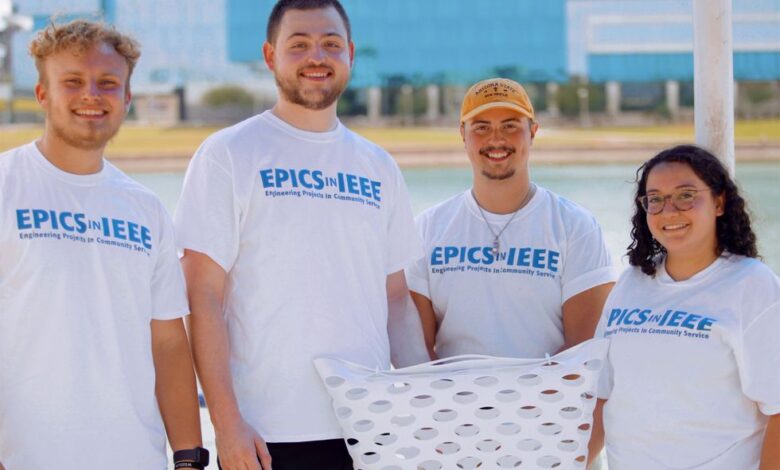Students Use Their Tech Know-How to Protect the Environment

Climate change is a problem for communities around the world. To help find ways to address it through technology,
EPICS in IEEE, in partnership with the United Engineering Foundation, launched the Environmental Competition last year.
According to the
Natural Resources Defense Council, climate change contributes to severe weather events such as hurricanes, flooding, and tornadoes, as well as long-term drought and regularly occurring heat events in traditionally moderate climate zones.
The EPICS contest asked students and faculty at U.S. universities and colleges to use their engineering and technical skills to mitigate and address the impact of climate change in their communities. Of the 20 proposals submitted from eight institutions, 10 were approved and funded.
The competition “allows students to take an idea, a passion, and turn it from a simple prototype to a fully deployed solution,” says
Stephanie Gillespie, associate dean of the University of New Haven’s engineering college, in Connecticut. Gillespie is the current EPICS in IEEE chair.
Service learning provides real-world experience
The student teams partnered with nonprofit organizations to learn how to make tangible impacts by developing technological solutions. Some teams are working on their projects as part of an engineering curriculum or a senior design project. Others are using their IEEE student branch to implement the projects.
“Being on a team with such a diverse collection of engineering disciplines really provides a well-rounded engineering experience,” says Mitzu Walkifucazaki, a junior studying computer science at
Arizona State University and a member of the group working on the Project Hydration Station, one of the winning projects. “I’ve learned so many things.”
A valuable learning experience for the students was the opportunity to work on multidisciplinary teams and engage in practical activities to apply what is taught in the classroom, according to the results of a survey students completed about the experience. More than 93 percent said their EPICS in IEEE project contributed to their development of teamwork skills.
A litter-collecting robot, nitrogen-sensing drones, and the other projects provided hands-on learning and community engagement experiences and helped the students develop professional skills.
Here are four of the 10 projects.
Waterproof sensors that track flooding
As part of the Sunny Day Flooding Project, Katherine Anarde, assistant professor in North Carolina State University’s Environmental, Water Resources, and Coastal Engineering Group [right] and another researcher install low-cost water-level sensors in storm drains.Thomas Thelen
Tidal flooding is a steadily increasing problem that affects thousands of people. The extent of a flood is often unknown, leaving community members with little to no direction as to what to expect—which creates dangerous situations. Students from
North Carolina State University, in Raleigh, along with two community volunteers, focused on providing the public with information such as the spatial and potential impacts of tidal flooding, through further research and a self-powered camera.
The electrical and computer engineering senior design project team is working with the North Carolina State
civil, construction, and environmental engineering and biological and agricultural engineering departments to implement the solution. The team plans to place hundreds of waterproof sensors in the state’s coastal cities. The sensors are designed to transmit data in real time to a secure, online gateway. The hope is to provide the data to communities.
“We envision that in the future there will be a network of these types of tools,” says
Natalie Nelson, assistant professor in the biological and agricultural engineering department. “This is just the start.”
A drone that detects nitrogen
IEEE student members Ye Wint Aung [left] and Shrawak Shakya from Ohlone College are showcasing a sensor system that displays the nitrogen levels within the soil in the box and the carbon dioxide levels in the room.Shaheer Alam
A high concentration of nitrogen and other gasses has reduced native plant species and the overall biodiversity in Fremont, Calif., and its environs. Seven
Ohlone College students who are part of the IEEE STEAM (STEM plus arts) Club in Fremont are working with two community volunteers to design a solution. Their Project DIANA uses a drone to detect gas concentrations in the air.
The team plans to present a final report on its findings to the
World Wildlife Fund.
When asked about the difference between school courses and Project DIANA,
Preyasi Shah, vice president of the IEEE STEAM Club, said the schoolwork is far less interactive.
“Our courses don’t teach us about the real-life applications of what we are learning,” Shah says. “You kind of have to go out and do that on your own.”
A solar electricity system for a community garden
At the Charles Madison Nabrit Memorial Garden in Columbus Ohio, Damon Nabrit [right] shows a participant how a FarmBot works. David A. Delaine
Access to fresh produce is challenging in many low-income neighborhoods. Thirty-five students and several faculty members from the
Ohio State University engineering college, in Columbus, designed an environmentally friendly solution. Project Urban Gardens for Sustainable Education and Agriculture is a climate-resilient community garden that grows produce for the community.
Working with the
Nabrit Memorial Garden and South Side Family Farms, the team is using solar electricity and rainwater to reduce the time and money spent watering the garden.
The project includes a STEM outreach program for neighboring schools. To help engage students, the Ohio State team wrote an instructional manual on how to build a replica FarmBot using a standard Lego Mindstorms EV3 kit. The FarmBot is an open-source robot that tends to vegetables. It can plant seeds, pick up tools, and weed and water the plants.
“This project has impacted the community, mostly the kids,” says Josh Williams, one of the university students working on the project.
A robot that removes litter
Trash is often found in and near bodies of water, threatening wildlife, community members, and the overall environment. Six students from
Arizona State University, in Tempe, created Project Lake Litter Solutions. The team is building a robot that can skim a body of water and collect trash from it before the debris sinks. The team used rapid prototyping equipment to build multiple versions for Tempe, and it hopes to expand the solution to other communities in the Phoenix area.
Mechanical engineering student
Kellen Worthington says the project gave the students the chance to work with a community partner and “really get some hands-on experience.”
“We believe that students can make a difference, and these experiences positively impact their learning, making the next generation of engineers stronger, more empathic, and aware of the impact they can have through technology.”
Jessica Maschino, another mechanical engineering major, says the EPICS program “helps with the application of the things that you are learning in the classroom.”
“This project will lead to cleaner lakes, cleaner parks, and cleaner golf courses,” adds
Dakota Edwards, another mechanical engineering major working on the project.
EPICS in IEEE’s impact
More than a dozen IEEE volunteers worked with eight universities and 132 university students to complete the EPICS in IEEE Environmental Competition projects.
Other projects in the competition were localized food systems, a hydration station, measuring nitrogen levels in a local river, and better aeration methods for a community fishery.
Once the 10 projects are deployed, it is estimated that more than 500,000 people will benefit.
EPICS in IEEE is a
donor-supported program through the IEEE Foundation. The program provides funding, support, mentorship, and visibility for engineering projects in four core categories of community improvement: access and abilities, environment, education and outreach, and human services. Since 2009, EPICS in IEEE has provided university and high school students with the opportunity to work with engineering professionals and nonprofit organizations to develop innovative solutions that transform communities worldwide.
“We believe that students can make a difference, and these experiences positively impact their learning, making the next generation of engineers stronger, more empathic, and aware of the impact they can have through technology,” Gillespie says.
If you are interested in submitting a project proposal or serving as a mentor, you can learn more at the EPICS in IEEE website. To stay current on all things EPICS,
sign up for its mailing list.
IEEE Spectrum




